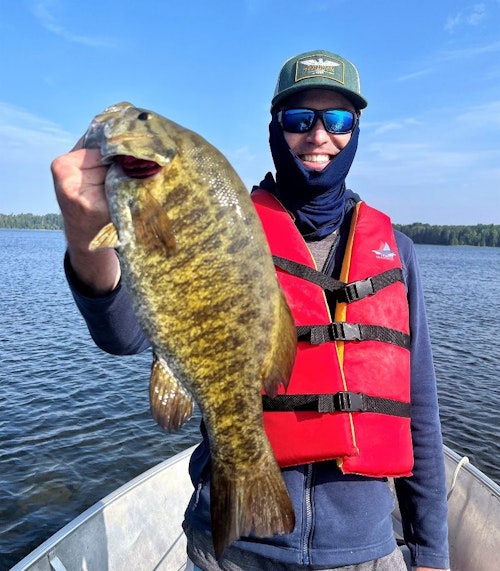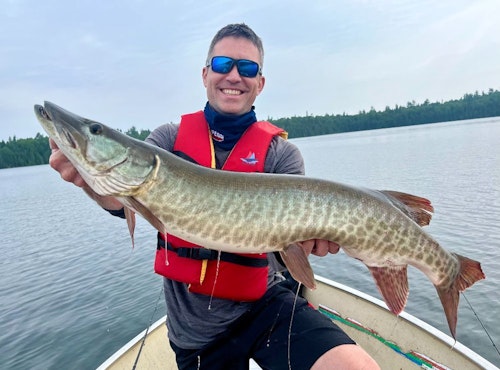After 4 hours of nothing, muskie fishing solo on a pristine portage lake in the Canadian bush, I decided to troll deep waters under the scorching sun.
Thirty seconds into the troll, my rod doubled under the weight of what felt like a college dorm mini-fridge. I felt movement and immediately knew it was game on.
The beast broke to the surface, thrashing about and revealing itself as the ultimate opponent: an angry muskie. After an intense battle, I netted the fish with one arm while holding the rod tightly with the other.
The flawless fish was just shy of 45 inches, and I carefully supported its weight with my chest and thigh as I snapped a quick selfie before releasing it to swim back to the depths.
The boat drifted only slightly from my trolling route during the fight, so I casted back toward the submerged weedline. On my second cast — my heart still racing from the big muskie — my rod bent sharply and line peeled out from my reel.
This fish went on long, deep runs and finally emerged as an ultra-fat, 41-inch pike — an Ontario Master Angler fish. I beamed ear to ear as I released the toothy critter.
That was one of the better 2-minute stretches of my fishing career, and an output of good fortune paired with a lifetime of learning. Here are four of my best muskie fishing tips which, as evidenced on that hot summer day, also apply to northern pike fishing.
1. Change One Variable at a Time
One of the hardest parts about muskie fishing is muskies are so difficult to pattern due to their relatively small sample size and reluctance to bite. When chasing muskies, my partner and I rotate between multiple rods with presentations that intentionally differ in style. That said, we naturally have our best baits in the water at our best spots a disproportionate amount of time.
This is where changing one variable at a time comes into play. On the day I wrote about above, for example, my dad and I had caught three nice muskies and several large pike in the morning before Dad headed in for lunch with my son while I grinded through the 4-hour lull ending in back-to-back trophy fish.
I ultimately went back to what had been our most effective presentation that day (an oversized, firetiger spinnerbait) at our most productive spot (a deepwater bay with submerged weeds off a rock pile) and changed one variable: The depth at which I fished in the water column.
Before trolling, I counted to 10 to allow my spinnerbait to drop to the bottom so my lure moved deeper in the water column. Same thing when casting and catching the pike. I knew fish were in the vicinity and had responded to that spinnerbait, so I changed one variable and that made all the difference.
One thing I avoid doing is trying a new or unproven lure on a new or unproven spot. If I don’t raise a muskie at that spot, I don’t know if it’s because that presentation isn’t working or because that spot isn’t holding fish. Changing one variable at a time allows me to better pattern muskies.


2. Finesse for the Fish of 10,000 Casts
Every muskie angler knows that big baits catch big fish. But I can’t stress enough how many more muskies and pike I have caught by virtue of downsizing and fishing finesse.
One of my go-to finesse presentations is a swimbait-style jighead with a 5-inch pearl white minnow or shad. This is especially killer casting in shallow water with prolonged pauses throughout the retrieval, or trolling in the fall while frequently sweeping the rod backwards and downward to create pauses that allow the jig to freefall.
Watch your line for movement as bites often occur on the drop, and even big fish will pick up the bait with an extremely light bite. Using a jig with a 3/0 or larger hook size allows you to upsize your plastic, especially in later fall, if you want to create a larger bait profile while still maintaining a finesse approach.
This is a good rig to keep ready on a spare rod in the boat to toss out in the direction of a muskie if you get one that follows and then slowly swims away from the boat.
One bonus to finesse fishing for muskies and pike? You catch more bonus bass along the way.

3. Come in Quietly for Muskies
Muskie fishing is hard enough, I don’t want to decrease my odds before my first cast. I take great care not to spook the fish, slowing the boat way down about 50 to 100 yards before I approach a spot. I get my trolling motor positioned during this time, and I play the wind so I can drift silently into a spot for the final 30 yards.
If approaching a spot so slowly tests your patience, use the time to watch your electronics for structure changes, baitfish or suspended muskies.
Rocket science? No. Helpful reminder — especially when you’re excited to work through all your best spots? Yes.

4. First Pass with Your Best Bait for Hook-Ups
I often deconstruct my day on the water afterward to think about what I could have done better. With muskie fishing, this can be both productive and painful.
Over the years, I’ve had days where I hook and lose one giant muskie on a lure that attracts attention but, statistically, results in more mis-strikes or fish coming unhooked. I’ve asked myself, “What would have happened if that fish instead bit on a lure with three sets of razor-sharp treble hooks?”
Due to this analysis, I always start fishing a spot with the applicable lure that has the highest hook-up rate. My line of thinking is if I have to throw lure “X” to get a fish to bite, even if lure “X” is notorious for mis-strikes and muskies coming un-glued, I obviously will.
But if I can get the muskie to hit lure “Y” instead — a lure with higher hook-up and landing rates — it increases my odds. What I want to avoid doing on my first pass through a spot is encountering a “hot” fish that likely would have bit any lure, but I chose to throw lure “X” first, which contributed to a mis-strike.
It’s a subtle thing, but over the years it adds up. I hope my tips add up to help you catch more muskies and pike in the year ahead.








